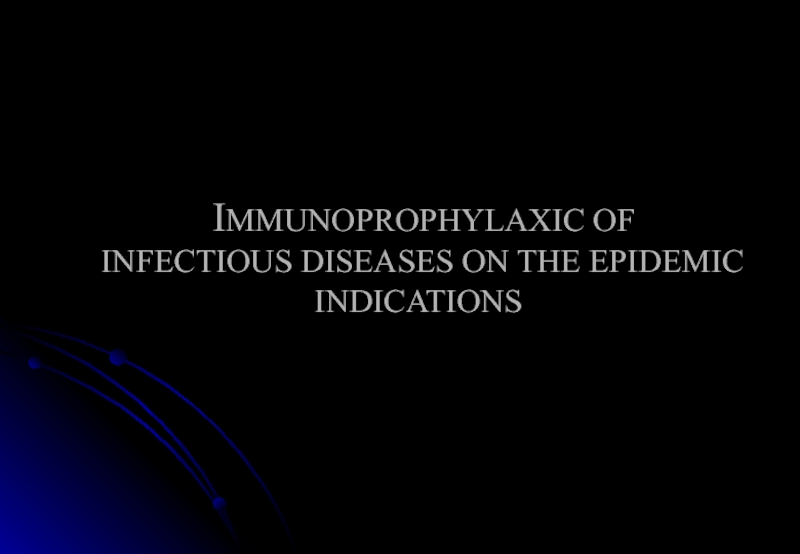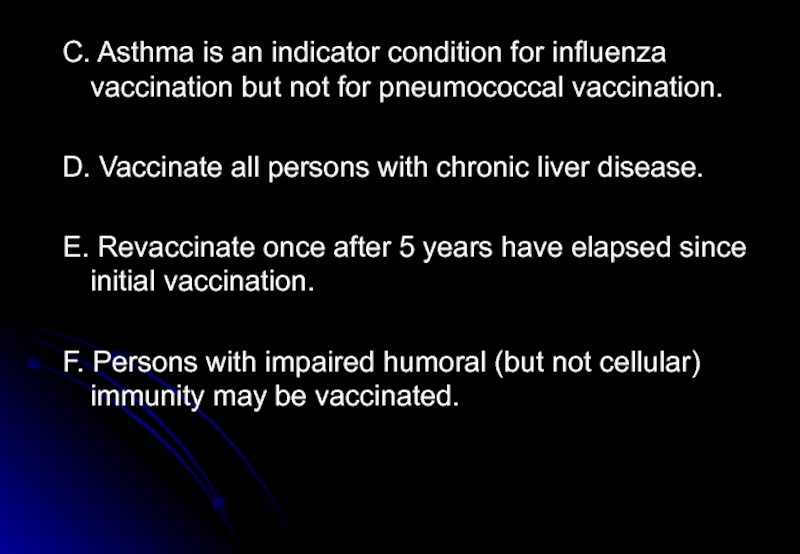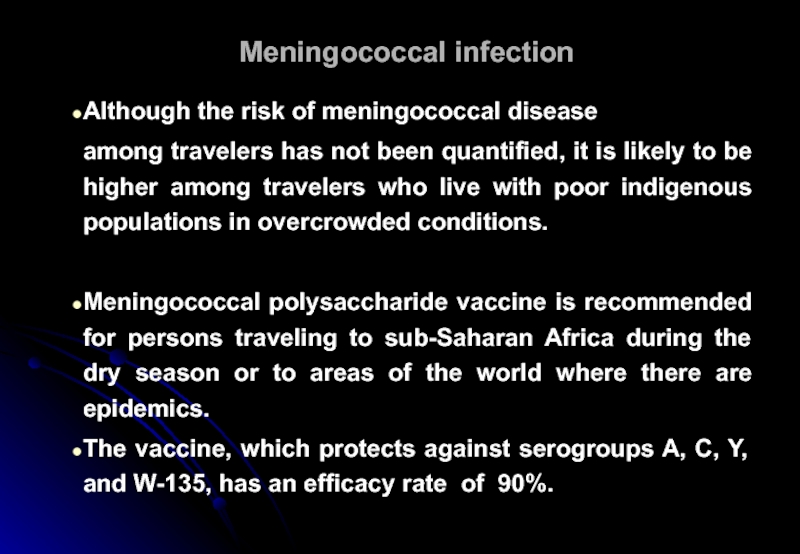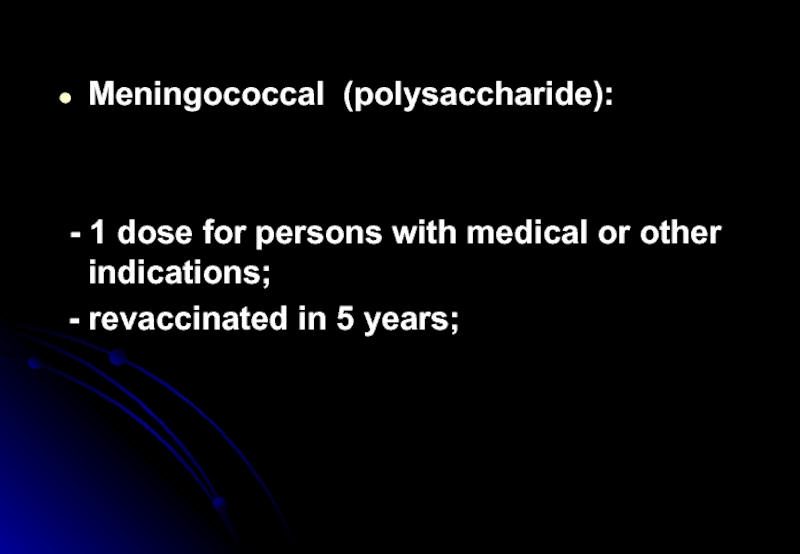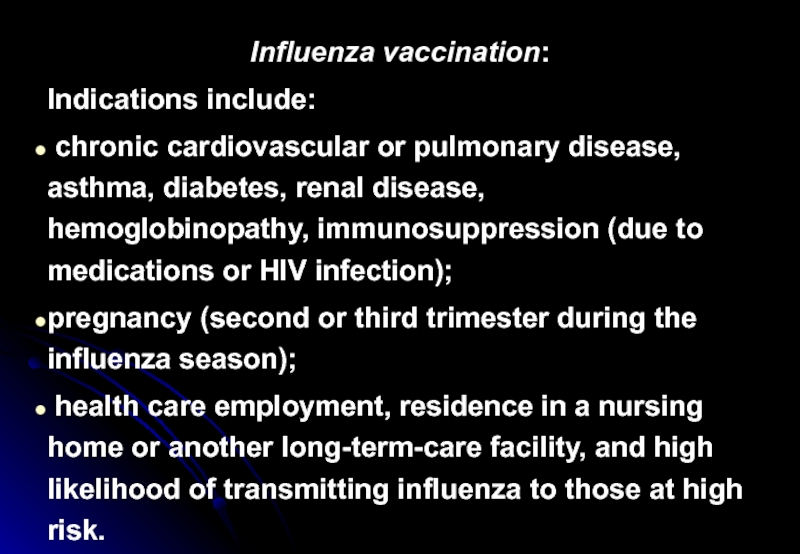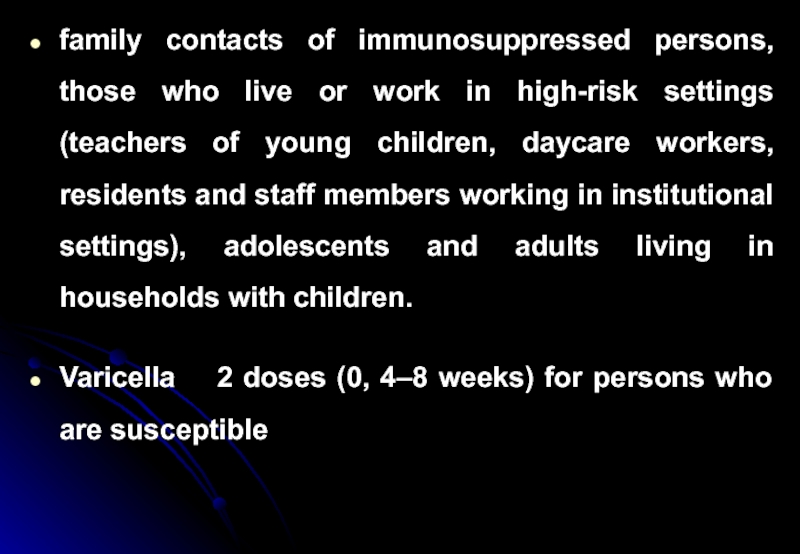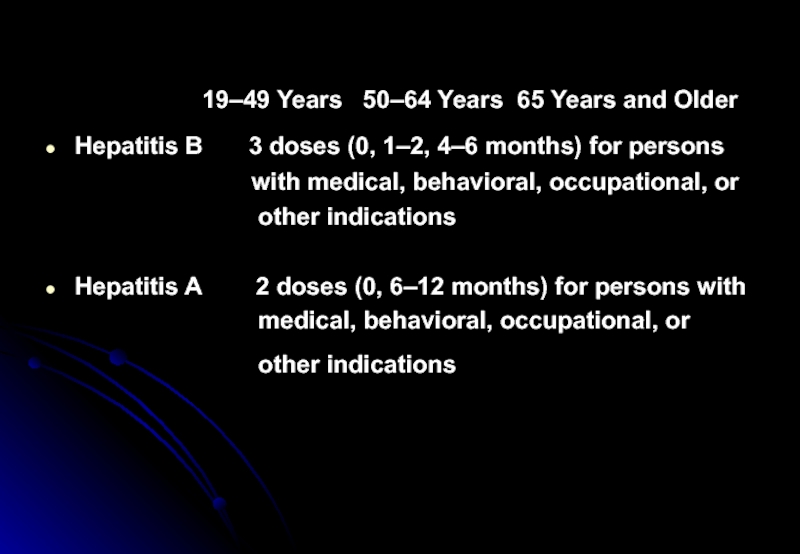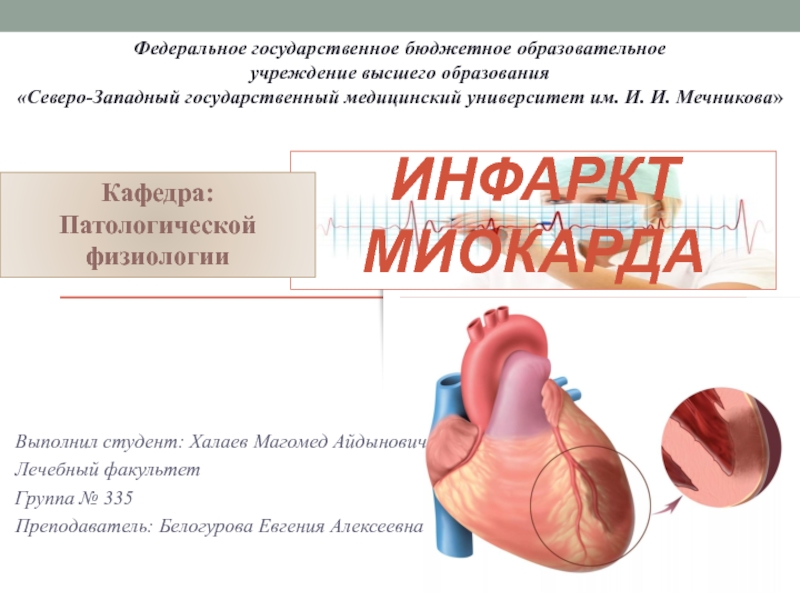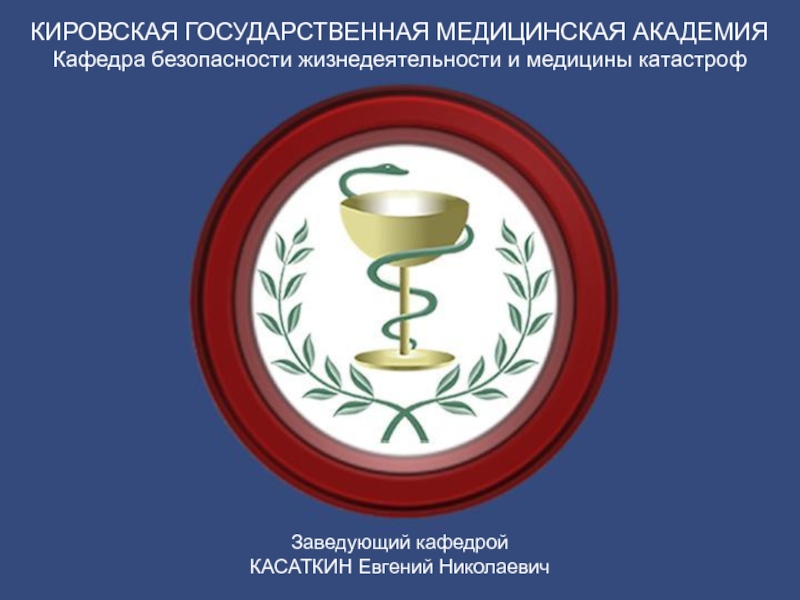- Главная
- Разное
- Дизайн
- Бизнес и предпринимательство
- Аналитика
- Образование
- Развлечения
- Красота и здоровье
- Финансы
- Государство
- Путешествия
- Спорт
- Недвижимость
- Армия
- Графика
- Культурология
- Еда и кулинария
- Лингвистика
- Английский язык
- Астрономия
- Алгебра
- Биология
- География
- Детские презентации
- Информатика
- История
- Литература
- Маркетинг
- Математика
- Медицина
- Менеджмент
- Музыка
- МХК
- Немецкий язык
- ОБЖ
- Обществознание
- Окружающий мир
- Педагогика
- Русский язык
- Технология
- Физика
- Философия
- Химия
- Шаблоны, картинки для презентаций
- Экология
- Экономика
- Юриспруденция
Immunoprophylaxic of infectious diseases on the epidemic indications презентация
Содержание
- 1. Immunoprophylaxic of infectious diseases on the epidemic indications
- 2. Plan of lecture Passive Immunization of the
- 3. Passive Immunization with Immunoglobulin Preparations
- 4. C. Asthma is an indicator condition for
- 5. G. Hemodialysis patients: Use special formulation of
- 6. J. Vaccinate as close to diagnosis as
- 7. Post-exposure Immunization with Immunoglobulin Preparations Measles
- 8. Rubella - efficacy is unreliable; therefore, standard
- 9. Tetanus - human tetanus immune globulin (TIG)
- 10. Rabies - human rabies immune globulin (RIG)
- 11. Hepatitis A - standard immune serum
- 12. Meningococcal infection Although the risk of meningococcal
- 13. Meningococcal vaccine, quadrivalent: Vaccination should be considered
- 14. Meningococcal
- 15. Pneumococcal infection Pneumococcal polysaccharide vaccination:
- 16. Revaccination with pneumococcal polysaccharide vaccine: One-time
- 17. Pneumococcal (polysaccharide) vaccine scheme 1 dose
- 18. Influenza vaccination: Indications include: chronic
- 19. Influenza - 1 dose
- 20. Varicella vaccination is recommended for all
- 21. family contacts of immunosuppressed persons, those
- 22. Measles, mumps, rubella (MMR) 1 dose if
- 23. Measles/mumps/rubella vaccination A second dose is recommended
- 24. Mumps component: - 1 dose of MMR
- 25. Tetanus and diphtheria (Td): A primary series
- 26. Rabies Many cases of rabies have
- 27. Countries where canine rabies is highly endemic
- 28. PREEXPOSURE RABIES VACCINATION Pre exposure
- 29. Once immunized against rabies with potent vaccines,
- 30. Persons in the high-risk and moderate-risk
- 31. Persons in the low-exposure category do not
- 32. Hepatitis A and B Hepatitis A is
- 33. The monthly incidence of hepatitis B infection,
- 34. Hepatitis A vaccination: For the combined HepA/HepB
- 35. Hepatitis B vaccination: Vaccination is indicated
Слайд 2Plan of lecture
Passive Immunization of the Immunoglobulin Preparations
Post-exposure Immunization of the
Immunoglobulin Preparations of infectious diseases
Слайд 3
Passive Immunization with Immunoglobulin Preparations
Vaccine may be given if
pregnancy is at second or third trimester during influenza season.
B. Although chronic liver disease and alcoholism are not indicator conditions for influenza vaccination, give 1 dose annually if the patient is 50 years old, has other indications for influenza vaccine, or requests vaccination.
B. Although chronic liver disease and alcoholism are not indicator conditions for influenza vaccination, give 1 dose annually if the patient is 50 years old, has other indications for influenza vaccine, or requests vaccination.
Слайд 4C. Asthma is an indicator condition for influenza vaccination but not
for pneumococcal vaccination.
D. Vaccinate all persons with chronic liver disease.
E. Revaccinate once after 5 years have elapsed since initial vaccination.
F. Persons with impaired humoral (but not cellular) immunity may be vaccinated.
D. Vaccinate all persons with chronic liver disease.
E. Revaccinate once after 5 years have elapsed since initial vaccination.
F. Persons with impaired humoral (but not cellular) immunity may be vaccinated.
Слайд 5G. Hemodialysis patients: Use special formulation of vaccine (40 g/mL) or
two 1.0-mL, 20-g doses given at one site. Vaccinate early in the course of renal disease. Assess antibody titers to hepatitis B surface antigen annually; administer additional doses if titers decline to 10 mIU/mL.
H. Also administer meningococcal vaccine.
I. In persons undergoing elective splenectomy, vaccinate at least 2 weeks before surgery.
H. Also administer meningococcal vaccine.
I. In persons undergoing elective splenectomy, vaccinate at least 2 weeks before surgery.
Слайд 6J. Vaccinate as close to diagnosis as possible, when CD4 cell
counts are highest.
K. Withhold MMR or other measles-containing vaccines from HIV-infected persons with evidence of severe immunosuppression.
(Approved by the Advisory Committee on Immunization Practices and accepted by the American College of Obstetricians and Gynecologists and the American Academy of Family Physicians.)
K. Withhold MMR or other measles-containing vaccines from HIV-infected persons with evidence of severe immunosuppression.
(Approved by the Advisory Committee on Immunization Practices and accepted by the American College of Obstetricians and Gynecologists and the American Academy of Family Physicians.)
Слайд 7Post-exposure Immunization with Immunoglobulin Preparations
Measles - standard human immune globulin
is recommended for exposed infants and adults with normal immunocompetence (but with a contraindication to measles vaccine) and for Immunocompromised patients exposed to measles (regardless of immunization status).
Patients should be actively immunized 3 to 6 months after immunoglobulin administration. Recommended dose: 0.25–0.50 mL/kg (40–80 mg of IgG/kg) IM; 80 mg of IgG/kg for immunocompromised contact; maximum, 15 mL.
Patients should be actively immunized 3 to 6 months after immunoglobulin administration. Recommended dose: 0.25–0.50 mL/kg (40–80 mg of IgG/kg) IM; 80 mg of IgG/kg for immunocompromised contact; maximum, 15 mL.
Слайд 8Rubella - efficacy is unreliable; therefore, standard human immune globulin is
recommended for administration only to antibody negative pregnant women in the first trimester who have a documented rubella exposure and will not consider terminating the pregnancy.
Recommended dose is 0.55 mL/kg (90 mg of IgG/kg) IM.
Recommended dose is 0.55 mL/kg (90 mg of IgG/kg) IM.
Слайд 9Tetanus - human tetanus immune globulin (TIG) has replaced equine tetanus
antitoxin because of the risk of serum sickness with equine serum.
Recommended dose for post-exposure prophylaxis is 250–500 units of TIG (10–20 mg of IgG/kg) IM. Recommended dose for treatment of tetanus is 3000–6000 units of TIG IM.
Recommended dose for post-exposure prophylaxis is 250–500 units of TIG (10–20 mg of IgG/kg) IM. Recommended dose for treatment of tetanus is 3000–6000 units of TIG IM.
Слайд 10Rabies - human rabies immune globulin (RIG) is preferred over equine
rabies antiserum because of the risk of serum sickness with equine serum.
RIG or antiserum is recommended for non-immunized individuals with animal bites in whom rabies cannot be ruled out and with other exposures to known rabid animals. Recommended dose of RIG is 20 IU/kg (22 mg of IgG/kg).
Recommended dose of antiserum is 40 IU/kg. Rabies vaccine is given as well at 0, 3, 7, 14, and 28 days.
RIG or antiserum is recommended for non-immunized individuals with animal bites in whom rabies cannot be ruled out and with other exposures to known rabid animals. Recommended dose of RIG is 20 IU/kg (22 mg of IgG/kg).
Recommended dose of antiserum is 40 IU/kg. Rabies vaccine is given as well at 0, 3, 7, 14, and 28 days.
Слайд 11
Hepatitis A - standard immune serum globulin is given in a
single dose of 0.02–0.04 mL/kg or (for continuous exposure) in a dose up to 0.06 mL/kg every 5 months.
Post-exposure treatment with hepatitis A immune
Post-exposure treatment with hepatitis A immune
Слайд 12Meningococcal infection
Although the risk of meningococcal disease
among travelers has not been
quantified, it is likely to be higher among travelers who live with poor indigenous populations in overcrowded conditions.
Meningococcal polysaccharide vaccine is recommended for persons traveling to sub-Saharan Africa during the dry season or to areas of the world where there are epidemics.
The vaccine, which protects against serogroups A, C, Y, and W-135, has an efficacy rate of 90%.
Meningococcal polysaccharide vaccine is recommended for persons traveling to sub-Saharan Africa during the dry season or to areas of the world where there are epidemics.
The vaccine, which protects against serogroups A, C, Y, and W-135, has an efficacy rate of 90%.
Слайд 13Meningococcal vaccine, quadrivalent:
Vaccination should be considered for adults with terminal complement
component deficiencies, those with anatomical or functional asplenia, college freshmen (especially those living in dormitories), and travelers to the “meningitis belt” in sub-Saharan Africa or to Mecca for the Hajj.
High-risk persons can be revaccinated in 5 years.
(Adaptedv from recommendations approved by the Advisory Committee on Immunization Practices and accepted by the American College of Obstetricians and Gynecologists and the American Academy of Family Physicians.)
High-risk persons can be revaccinated in 5 years.
(Adaptedv from recommendations approved by the Advisory Committee on Immunization Practices and accepted by the American College of Obstetricians and Gynecologists and the American Academy of Family Physicians.)
Слайд 14
Meningococcal (polysaccharide):
- 1 dose
for persons with medical or other indications;
- revaccinated in 5 years;
- revaccinated in 5 years;
Слайд 15Pneumococcal infection
Pneumococcal polysaccharide vaccination:
Indications include chronic cardiovascular or pulmonary
disease (except asthma), diabetes, chronic liver disease, chronic renal failure or nephritic syndrome, asplenia, immunosuppression, certain cancer chemotherapy, and long-term systemic glucocorticoid therapy.
Vaccination is also indicated in Alaskan natives, certain Native American populations, and residents of nursing homes and other long-term-care facilities.
Vaccination is also indicated in Alaskan natives, certain Native American populations, and residents of nursing homes and other long-term-care facilities.
Слайд 16Revaccination with pneumococcal polysaccharide vaccine:
One-time revaccination after age 5 is
indicated for persons with chronic renal failure or nephrotic syndrome, asplenia, immunosuppression, certain cancer chemotherapy, or long-term systemic glucocorticoid therapy.
Persons 65 years old should undergo one-time revaccination if their prior vaccination was at least 5 years before and was given before age 65.
Persons 65 years old should undergo one-time revaccination if their prior vaccination was at least 5 years before and was given before age 65.
Слайд 17
Pneumococcal (polysaccharide) vaccine
scheme
1 dose for persons with medical or other indication
1
dose revaccination for immunosuppressive conditions
1 dose for unvaccinated persons
1 dose revaccination
1 dose for unvaccinated persons
1 dose revaccination
Слайд 18Influenza vaccination:
Indications include:
chronic cardiovascular or pulmonary disease, asthma, diabetes,
renal disease, hemoglobinopathy, immunosuppression (due to medications or HIV infection);
pregnancy (second or third trimester during the influenza season);
health care employment, residence in a nursing home or another long-term-care facility, and high likelihood of transmitting influenza to those at high risk.
pregnancy (second or third trimester during the influenza season);
health care employment, residence in a nursing home or another long-term-care facility, and high likelihood of transmitting influenza to those at high risk.
Слайд 19
Influenza - 1 dose annually for persons with medical or occupational
indications, or household contacts of persons
Слайд 20Varicella vaccination is recommended for
all persons without a reliable clinical
history of varicella or serologic evidence of immunity;
health care workers;
women who are not pregnant but intend to become pregnant in the future;
health care workers;
women who are not pregnant but intend to become pregnant in the future;
Слайд 21
family contacts of immunosuppressed persons, those who live or work in
high-risk settings (teachers of young children, daycare workers, residents and staff members working in institutional settings), adolescents and adults living in households with children.
Varicella 2 doses (0, 4–8 weeks) for persons who are susceptible
Varicella 2 doses (0, 4–8 weeks) for persons who are susceptible
Слайд 22Measles, mumps,
rubella (MMR)
1 dose if measles, mumps, or rubella vaccination history
is unreliable;
2 doses for persons with occupational or other indications;
Measles component:
Adults born before 1957 are considered immune to measles.
Adults born after 1957 should have at least 1 dose of MMR vaccine barring a medical contraindication or documentation of prior immunization.
2 doses for persons with occupational or other indications;
Measles component:
Adults born before 1957 are considered immune to measles.
Adults born after 1957 should have at least 1 dose of MMR vaccine barring a medical contraindication or documentation of prior immunization.
Слайд 23Measles/mumps/rubella vaccination
A second dose is recommended for adults
who have recently
been exposed to measles in an outbreak setting,
who have previously received killed measles vaccine,
who were vaccinated with an unknown measles vaccine between 1963 and 1967,
who are students at a college or university,
who work in health care facilities, or who plan to travel internationally.
who have previously received killed measles vaccine,
who were vaccinated with an unknown measles vaccine between 1963 and 1967,
who are students at a college or university,
who work in health care facilities, or who plan to travel internationally.
Слайд 24Mumps component:
- 1 dose of MMR vaccine is adequate.
- Rubella
component: 1 dose of MMR vaccine should be given to women whose history is unreliable, with counseling to avoid becoming pregnant for 4 weeks.
The rubella immune status of women of childbearing age should be ascertained and counseling provided regarding congenital rubella.
The rubella immune status of women of childbearing age should be ascertained and counseling provided regarding congenital rubella.
Слайд 25Tetanus and diphtheria (Td):
A primary series for adults is 3 doses,
with the first 2 doses at least 4 weeks apart and the third dose 6 to 12 months after the second.
One dose suffices if a primary series was completed 10 years before. In addition to a teenage/young adult booster, adults 50 years of age who have completed the full series plus booster should receive one more dose.
One dose suffices if a primary series was completed 10 years before. In addition to a teenage/young adult booster, adults 50 years of age who have completed the full series plus booster should receive one more dose.
Слайд 26Rabies
Many cases of rabies have been reported in travelers, but
there are no data on the risk of infection.
Domestic animals, primarily dogs, are the major transmitters of rabies in developing countries.
Several studies have shown that the risk of rabies posed by a dog bite in an endemic area ranges from 1 to 3.6 cases per 1000 travelers per month of stay.
Domestic animals, primarily dogs, are the major transmitters of rabies in developing countries.
Several studies have shown that the risk of rabies posed by a dog bite in an endemic area ranges from 1 to 3.6 cases per 1000 travelers per month of stay.
Слайд 27Countries where canine rabies is highly endemic include Mexico, the Philippines,
Sri Lanka, India, Thailand, and Vietnam.
The three vaccines available in the United States provide 90% protection.
Rabies vaccine is recommended for long-stay travelers, particularly children, and persons who may be occupationally
exposed to rabies in endemic areas.
The three vaccines available in the United States provide 90% protection.
Rabies vaccine is recommended for long-stay travelers, particularly children, and persons who may be occupationally
exposed to rabies in endemic areas.
Слайд 28
PREEXPOSURE RABIES VACCINATION
Pre exposure rabies vaccination is available to persons
at risk of rabies exposure.
The ACIP recommends a series of 1-mL doses of modern cell culture vaccine administered intramuscularly on days 0, 7, and 21 or 28.
The ACIP recommends a series of 1-mL doses of modern cell culture vaccine administered intramuscularly on days 0, 7, and 21 or 28.
Слайд 29Once immunized against rabies with potent vaccines, individuals are primed against
rabies for the rest of their lives.
If an exposure occurs, a previously immunized person should receive postexposure boosters consisting of two doses 3 days apart.
If an exposure occurs, a previously immunized person should receive postexposure boosters consisting of two doses 3 days apart.
Слайд 30
Persons in the high-risk and moderate-risk rabies exposure categories should have
their rabies virus–neutralizing antibody titers monitored every 6 months and every 2 years, respectively.
Слайд 31Persons in the low-exposure category do not require serologic monitoring but,
like all previously immunized persons, must receive the two booster vaccinations upon exposure to rabies.
Moreover, appropriate wound care (i.e., copious flushing and the use of soap or detergent) remains critical.
Moreover, appropriate wound care (i.e., copious flushing and the use of soap or detergent) remains critical.
Слайд 32Hepatitis A and B
Hepatitis A is the most frequent vaccine-preventable infection
of travelers; Swiss data show that the incidence of symptomatic infection during a 1-month stay in a developing country ranges from 3 to 6 cases per 1000.
The mortality rate for hepatitis A increases with age, reaching almost 3% among symptomatic individuals over age 50. Of the four hepatitis A vaccines currently available in North America (two in the United States), all are interchangeable and have an efficacy rate of 95%.
The mortality rate for hepatitis A increases with age, reaching almost 3% among symptomatic individuals over age 50. Of the four hepatitis A vaccines currently available in North America (two in the United States), all are interchangeable and have an efficacy rate of 95%.
Слайд 33The monthly incidence of hepatitis B infection, both symptomatic and asymptomatic,
is 80 to 240 cases per 100,000. For reasons that are not entirely clear, long-stay overseas workers are at considerable risk for hepatitis B infection.
A combined hepatitis A and B vaccine is now available and has been approved for administration on a 3-week accelerated schedule in Canada and Europe.
A combined hepatitis A and B vaccine is now available and has been approved for administration on a 3-week accelerated schedule in Canada and Europe.
Слайд 34Hepatitis A vaccination:
For the combined HepA/HepB vaccine, use 3 doses at
0, 1, and 6 months.
Hepatitis A vaccination is indicated in persons with clotting factor disorders or chronic liver disease, men who have sex with men, users of injection and non-injection illegal drugs, persons working with hepatitis A virus–infected primates or working with the virus in a laboratory, and persons traveling to or working in countries with high prevalence.
Hepatitis A vaccination is indicated in persons with clotting factor disorders or chronic liver disease, men who have sex with men, users of injection and non-injection illegal drugs, persons working with hepatitis A virus–infected primates or working with the virus in a laboratory, and persons traveling to or working in countries with high prevalence.
Слайд 35Hepatitis B vaccination:
Vaccination is indicated for hemodialysis patients, patients receiving
clotting factor concentrates, health care workers and public safety workers exposed to blood, students in the health professions, injection drug users, persons with multiple sex partners within 6 months, patients with recent sexually transmitted disease (STD), clients of STD clinics, men who have sex with men, household contacts and sex partners of persons with chronic hepatitis B virus infection, clients and staff of institutions for the mentally disabled, inmates of correctional institutions, and international travelers to countries with high prevalence.
Слайд 36
19–49 Years
50–64 Years 65 Years and Older
Hepatitis B 3 doses (0, 1–2, 4–6 months) for persons
with medical, behavioral, occupational, or
other indications
Hepatitis A 2 doses (0, 6–12 months) for persons with
medical, behavioral, occupational, or
other indications
Hepatitis B 3 doses (0, 1–2, 4–6 months) for persons
with medical, behavioral, occupational, or
other indications
Hepatitis A 2 doses (0, 6–12 months) for persons with
medical, behavioral, occupational, or
other indications
